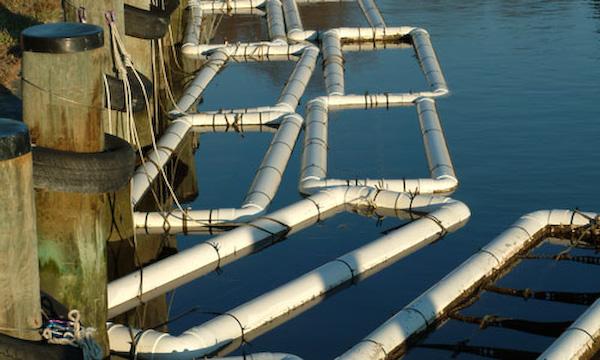“Color added” on a label for salmon and salmon products means that the salmon were given a feed which contains a pigment called astaxanthin. When the feed is digested, the astaxanthin is absorbed into the fish’s flesh giving the fillets or steaks a reddish or ‘salmon’ color. Astaxanthin is pigment occurring in nature that gives flamingos their pink coloration. It also turns cooked shrimp and crabs an orange-red color. In the wild, salmon get astaxanthin through their diets, which consist …
Seaweed Aquaculture: An Introduction
 The seaweeds (or sea vegetables) are a large and diverse group of marine macroalgae that can be found in intertidal and subtidal coastal regions around the world. Like land plants, they utilize photosynthesis to convert inorganic nutrients into organic biomass, an important link that provides food, shelter, and habitat for other organisms. Seaweeds are simple in their structural compositions because they take up nutrients into their blades or fronds directly from the seawater, unlike more complex land plants which take …
The seaweeds (or sea vegetables) are a large and diverse group of marine macroalgae that can be found in intertidal and subtidal coastal regions around the world. Like land plants, they utilize photosynthesis to convert inorganic nutrients into organic biomass, an important link that provides food, shelter, and habitat for other organisms. Seaweeds are simple in their structural compositions because they take up nutrients into their blades or fronds directly from the seawater, unlike more complex land plants which take …
Seaweed Aquaculture: Kelp

Kelp is a healthy and nutritious sea vegetable that is high in fiber, vitamins, and minerals, including vitamin C, vitamin K, iron, calcium, iodine, and magnesium. Kelp has long been part of the diet of Asian cultures, and, in fact, Saccharina japonica (a relative of our native Saccharina latissima) is the number one aquacultured species worldwide by weight. Although the majority of kelp marketed in the US is harvested from the wild, the development of a kelp culture industry, …
Business Planning in Marine Aquaculture
 This article will provide a brief introduction to business planning for marine aquaculture.
This article will provide a brief introduction to business planning for marine aquaculture.
Business planning for a marine aquaculture venture is no different than planning for starting any other type of business entity. One must consider investment costs, operating costs, permitting and regulatory issues, marketing your product and generating a positive cash flow.
The first step in the process is determining the profit you would like to make from your venture. Many people assume all they need to do is …
Seaweed Aquaculture: Gracilaria
Gracilaria

The genus Gracilaria, in the Phylum Rhodophyta (the red seaweeds), contains over 100 species found around the world, and many are wild harvested and cultivated for food and the phycocolloid agar. Known as ogo or ogonori in Japan and Hawaii, Gracilaria is a popular ingredient in salads, usually sold fresh or salted. Agar is a gel-forming polysaccharide extracted from the cell walls of Gracilaria species, and is especially important in the food and microbiological industries. Gracilaria is a …
2012 eXtension Virtual Aquaculture Workshop
eXtension Virtual Aquaculture Workshop 2012
The Freshwater Aquaculture Community of Practice will present a virtual workshop including an introduction to aquaculture, an in depth look at pond culture and management, overviews on a variety of species, and a full hour covering aquaponics. This session is open to anyone interested in learning more about aquaculture in the US. If interested or have questions about attending this workshop please contact Vanessa Weldon vmaxwell24@gmail.com
